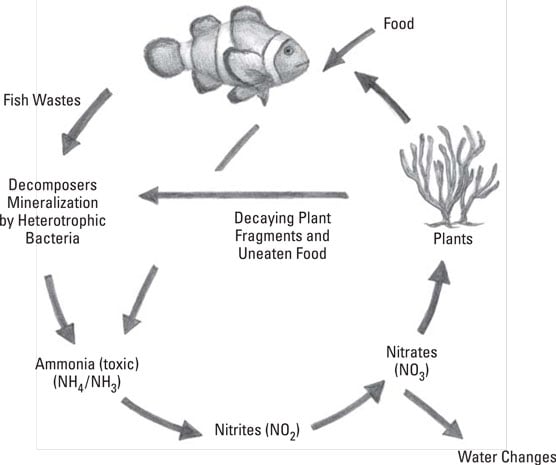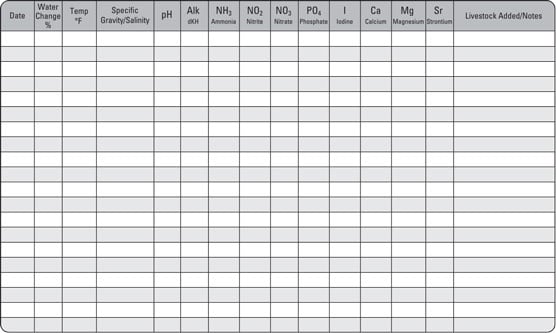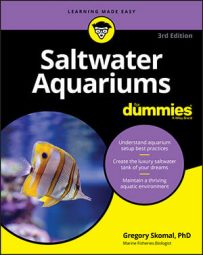In the aquarium, these wastes must be removed. Carbon dioxide (CO2) generally leaves the water through water circulation and aeration at the surface or through photosynthesis by aquarium algae. Ammonia, on the other hand, must be converted to nitrite, which is then converted to nitrate, a less toxic compound. This conversion of harmful ammonia into nitrite and then nitrate is called the nitrogen cycle.
 The nitrogen cycle is key to making your aquarium habitable.
The nitrogen cycle is key to making your aquarium habitable.Why do you need to know about the nitrogen cycle? Because it’s the basis of biological filtration, and your filters use biological filtration to keep your aquarium clean. Without biological filtration, your aquarium won’t survive!
Your marine animals aren’t the only source of nitrogenous wastes. Every time you feed your pets, excess food will decompose into harmful compounds, including ammonia. That is why you need to make every effort to feed your fish carefully so as not to leave excess food in the aquarium.
Before you can fully stock an aquarium, you need to establish the nitrogen cycle. The following sections help you do so.The role of bacteria in the nitrogen cycle
A healthy aquarium depends greatly on the nitrogen cycle to reduce toxic ammonia into less-toxic nitrogen compounds. In your aquarium, ammonia builds slowly but decreases as it’s converted to nitrite. Then as the nitrite is converted to nitrate, nitrite decreases, and nitrate slowly accumulates. Ultimately, your healthy aquarium will have consistently low levels of ammonia and nitrite, while nitrate slowly builds.Biological filtration is actually bacteriological filtration. Believe it or not, the nitrogen cycle is driven by bacteria. Bacteria that convert ammonia (NH4) into nitrite (NO2) belong to the genus Nitrosomonas. Nitrite, in turn, is converted into nitrate (NO3) by bacteria of the genus Nitrobacter. These processes together are called nitrification.
You may be wondering what happens to the nitrate. Well, nitrate will be assimilated by algae, and it will be converted to nitrogen gas by denitrifying bacteria. In most aquarium systems, however, nitrate slowly accumulates in the water because these two processes generally can’t keep up with nitrate production.Although nitrate is relatively harmless to fish, it must eventually be removed or diluted before toxic levels are reached. You do this with frequent water changes (removing a portion of the aquarium water and replacing it with fresh batches of premixed salt water).
How to test the nitrogen cycle
The nitrogen cycle needs to be established in a biological filter, which is a requirement for all marine aquariums. Even with a properly functioning biological filter, however, you want to frequently monitor the levels of ammonia, nitrite, and nitrate. You do this with commercial test kits that are available at your fish dealer.With the test kits, you can watch the cycle as it develops in your aquarium, and you’ll see your aquarium mature. I discuss what a mature aquarium looks like in the next section.
Keep in mind that most serious fish dealers provide free water testing. Take full advantage of this service, because it allows you to compare the dealer’s results with those that you’re getting at home.
Write down and date the results of your water testing so that you can follow the nitrogen cycle. Figure 12-2 shows an example of what my records look like. Feel free to model yours after mine. By keeping these records, you’ll know when the cycle is firmly established in your aquarium. I even plot my results in a spreadsheet program, so I can see the rise and fall of ammonia and nitrite — I guess that makes me officially a fish geek. Some websites and apps are available where you can post your test parameters; they even make the charts for you.
 An example of recordkeeping.
An example of recordkeeping.
